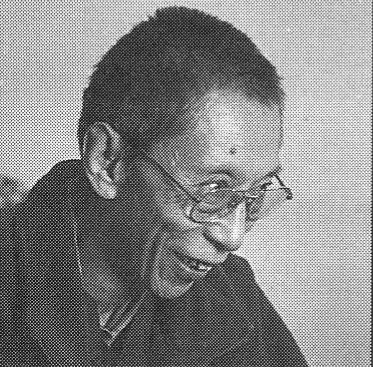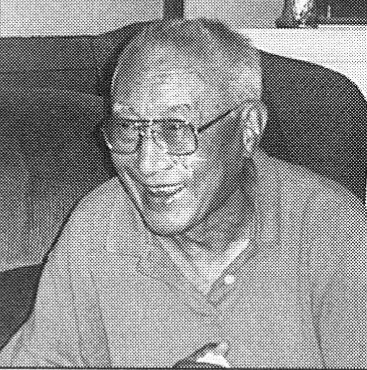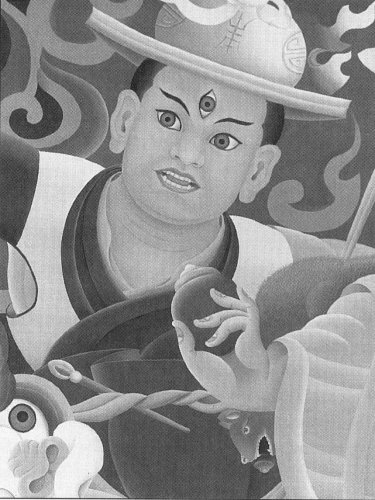
We believe that Dorje Shugden is a buddha.
– Geshe Kelsang Gyatso, founder of the New Kadampa Tradition, who organized demonstrations against the Dalai Lama during the summer of 1996

This worship of Dorje Shugden is not a religion at all. It is a cult.
– Thubten Jigme Norbu, brother of the Dalai Lama
To understand both sides of the Shugden debate, Professor Lopez interviewed Geshe Kelsang Gyatso, founder of the New Kadampa Tradition, an advocate of Dorje Shugden worship, and the author of fifteen books, including Universal Compassion and Essence of Vajrayana; andThubten Jigme Norbu, who opposes Shugden worship. Jigme Norbu is professor emeritus of Tibetan studies at Indiana State University, and founder of Rangzen, the International Tibetan Independence Movement. He is the brother of His Holiness the Dalai Lama.
On the night of February 4, 1997, a prominent Tibetan monk and two of his disciples were butchered to death near Dharamsala, India, the Dalai Lama’s capital-in-exile. The reportedly ritualistic violence inflicted on Geshe Losang Gyatso, the seventy-year-old principal of the Institute of Buddhist Dialectics, and two young monks in their twenties was immediately identified in the press as a “cult murder” and the cult identified as the “Shugdens.”
There is no mention of such a cult or sect in the history of Tibetan Buddhism, but there is a deity named Shugden, or more fully, Dorje Shugden, the “Powerful Thunderbolt,” a wrathful deity who seems to have originated in the seventeenth century, and who has been at the heart of a controversy in the Tibetan refugee community for the last twenty years.
The controversy has remained largely unknown to Westerners, but it reached public attention in the summer of 1996, when the disciples of Geshe Kelsang Gyatso of the New Kadampa Tradition picketed the Dalai Lama in London, accusing him of restricting their religious freedom. The point of contention is the worship of Dorje Shugden, which the Dalai Lama has asked his followers to abandon.
Lobsang Gyatso was a strong proponent of His Holiness’s position, which fueled assumptions that his murder was an act of revenge by pro-Shugden forces. Many news reports implied that the devotees of Shugden, most notably Geshe Kelsang Gyatso, somehow supported the murders. In fact, he, along with other “pro-Shugden” groups, have publicly condemned the murders in Dharamsala. Although no arrests have been made at this time, the Indian police now have identified suspects with links to the Shugden Committee in Delhi. The Shugden Committee has denied any connection with the murders.

Shugden is an important protective deity of the Gelug sect of Tibetan Buddhism. According to myth, he is the spirit of a learned and virtuous Gelug monk of the seventeenth century. This monk, Tulku Drakpa Gyaltsen (1619-1655), had been one of the candidates considered for selection as the Fifth Dalai Lama. Another child was chosen, however, and Tulku Drakpa Gyaltsen was subsequently named as the incarnation of another prominent lama of the Gelug sect. All this occurred before the Fifth Dalai Lama became temporal ruler of Tibet in 1642. Thus, during their youth, the Dalai Lama was an important—but not the most important—Gelug tulku, and lived not in the Potala (which had not yet been constructed), but in Drepung monastery in a place called the Lower House, while Tulku Drakpa Gyaltsen lived in the so-called Upper House. There seems to have been rivalry between the Fifth Dalai Lama and Tulku Drakpa Gyaltsen, or at least rivalry between their followers. As the story goes, one day Tulku Drakpa Gyaltsen defeated the Dalai Lama in debate. Shortly thereafter he was found dead, with a ceremonial scarf stuffed down his throat. He had either been murdered or committed suicide.
Soon, central Tibet in general and the Tibetan government in particular suffered a series of calamities. A mysterious force even overturned the dishes when the Fifth Dalai Lama was served his noon meal. Eventually, the source of the difficulty was identified as the spirit of Tulku Drakpa Gyaltsen, and various lamas and magicians were called in to exorcise the wrathful spirit. After they had all failed, the government of the Dalai Lama and the hierarchy of the Gelug sect propitiated the spirit, asking that he desist from harm and instead become a protector of the Gelug. The spirit agreed, and since that time Shugden has become one of the chief protectors of the Gelug sect, its monks, and its monasteries.
One of Shugden’s particular functions has been to protect the Gelugpa sect from the influence of the Nyingma. According to some accounts, he is said to punish those who attempt to practice a mixture of the two. The worship of Shugden underwent a revival in the first decades of this century, led by the famous Gelugpa monk Pabongka, (1878-1943). Pabongka was the guru of many of the most important Gelug monks of this century, including, most prominently, Trijang Rinpoche (1901-1981) of Ganden monastery, the junior tutor of the current Dalai Lama and thus one of the two most important Gelug monks in the refugee community. Trijang Rinpoche was a strong proponent of Shugden and the current Dalai Lama himself included prayers for Shugden in his nightly practice for many years.
After fleeing to India where he had to form and head a government-in-exile to represent the interests of all Tibetans, the Dalai Lama, beginning in 1976, discouraged the propitiation of Shugden on the advice of the Nechung oracle, saying that he personally disapproved of the practice and did not wish those who were associated with him, either as his disciples or as members of his government, to publicly worship Shugden. Contrary to the view of many Gelug monks, the Dalai Lama saw Shugden not as a buddha or the incarnation of the Tulku Drakpa Gyaltsen, but as a worldly god, even an evil spirit, whose worship promoted sectarianism in the refugee community and thus was inimical to the greater cause of Tibetan independence. The Dalai Lama’s renunciation of Shugden caused great discord within the Gelugpa community, where devotion to the deity remained strong among the Gelug hierarchy, albeit covertly in some cases. Spirited defenses of his worship were written and published.
In 1996, the Dalai Lama renewed his opposition. He refused to give tantric initiation to those who had not renounced Shugden, feeling that to do so would create a karmic relation that would be detrimental to his health. Supporters of Shugden claimed that statues of the deity were being destroyed by zealous supporters of the Dalai Lama’s position and that monks were being pressured to sign statements denouncing the deity. On July 15, 1996, the Tibetan government-in-exile issued a statement that read in part:
The government departments and their subsidiaries, as well as monastic institutions functioning under the administrative control of the CentralTibetan Administration, should be strictly forbidden from propitiating this spirit. Individual Tibetans, it said, must be informed of the demerits of propitiating this spirit, but be given freedom to “decide as they like.”
The resolution, however, requested the propitiators of this spirit not to receive vajrayana teachings from His Holiness the Dalai Lama.
The government-in-exile asked the abbot of Sera monastery, a traditional center of Shugden devotion, to provide the names of any monks who continued to worship the deity. The Holder of the Throne of Ganden, the head of the Gelugpa sect (appointed by the Dalai Lama), issued a statement denouncing the worship of Shugden. Those monks who had criticized the Dalai Lama for his proscription of Shugden he accused of “devoting time in framing detrimental plots and committing degrading acts, which seems no different from the act of attacking monasteries wielding swords and spears and drenching the holy robes of the Buddha with blood.”
One of the monks who denounced the Dalai Lama’s decree was Geshe Kelsang Gyatso, a monk of Sera monastery who in 1991 founded the New Kadampa Tradition (NKT) in England. Born in Tibet in 1932, Kelsang Gyatso has written numerous works on Mahayana and Vajrayana practice from the Gelugpa perspective. Like many of the most prominent Gelug lamas to come to the West (including Geshe Rabten, Gelek Rinpoche, and Geshe Gyaltsen), Geshe Kelsang Gyatso was a disciple of Trijang Rinpoche, for whom devotion to Shugden had been very important. Geshe Kelsang Gyatso made the worship of Dorje Shugden as dharma protector an important part of the New Kadampa Tradition. In the summer of 1996, the disciples of Kelsang Gyatso denounced the Dalai Lama for impinging on their religious freedom, and picketed against him during his visit to Britain, accusing him of intolerance.
The demonstrations made front-page news in the British press, which collectively rose to the Dalai Lama’s defense and in various reports depicted the New Kadampa Tradition as a fanatic, empire-building, demon-worshiping cult. The demonstrations were a public relations disaster for the NKT, not only because of their treatment by the press, but because of the absence of any historical information, portraying Shugden as a remnant of Tibet’s primitive pre-Buddhist past. The NKT’s allegiance to Shugden appeared to Westerners to be an aberration on the landscape of the Tibetan diaspora rather than an issue at the center of questions of Tibetan national identity. Yet while many Tibetans would never publicly challenge the Dalai Lama, the worship of Dorje Shugden remains widespread, and there is nothing to suggest that the controversy will quickly subside.
Thank you for subscribing to Tricycle! As a nonprofit, we depend on readers like you to keep Buddhist teachings and practices widely available.